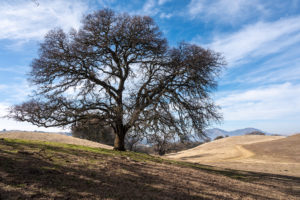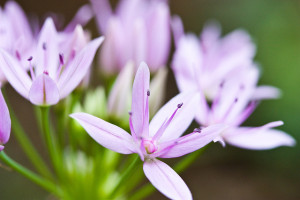Visit Bay Area coastal scrub or chaparral in spring to find these particularly Californian habitats at their most welcoming. It’s when their soft sages, chamise, ceanothus, and other low-lying plants start to unfurl, early wildflowers peek out between green grasses, and the earth is soft and moist underfoot. Chipping and chirping, towhees and scrub jays set and defend their territories amid the plants and practice their mating songs.
Wander along and you’ll soon find the ubiquitous coyote brush (Baccharis pilularis). A distinguishing species of coastal scrub and chaparral, it hides and shades birds and mammals and wicks dew from the air, sending it down into the soil during the dry season. But an overlooked herbivore, perhaps the shrub’s greatest Achilles’ heel, can defeat this hardy plant’s defenses: the glittering and exquisite coyote brush leaf beetle (Trirhabda flavolimbata).
Sign up today!

When you find coyote brush, and if you look closely on a spring day, you may catch the emerald gleam of this beetle. Once you see one, you’ll likely spot these representatives of the subfamily Galerucinae, skeletonizing leaf beetles, around the immediate area. Skeletonizing leaf beetles are just what they sound like, insects that masticate the soft tissues of a leaf, leaving behind the harder stem, veins, and midribs. Larvae of this beetle subfamily amass on their host plants, feasting on growing leaves, living and mating during the plant’s peak growing season, laying eggs, and dropping frass (invertebrate poop).
Dominating a Bay Area coastal scrubland landscape is no easy feat for any species. It includes adapting to hot and long dry seasons, invasive grasses, a semi-frequent fire cycle, and herbivores for every season. But the coyote brush is equipped with considerable advantages. Its crown root can reach down as far as 10 feet into the soil, and lateral roots spread in every direction, collecting groundwater long into the dry season. The plant can resprout after a low- intensity brushfire if the root stem remains unscathed. Waxy leaves, impenetrable to many invertebrates, are just plain unpalatable to deer. Its flowers attract parasitic wasps that prey upon other insects that might eat the shrub.
Yet the coyote brush leaf beetle makes this inhospitable plant home during every stage of its life cycle. Hatching from eggs in February, blue-green and shining larvae climb to the buds and leaves of the coyote brush, where they will eat and grow unceasingly for several weeks, nearly reaching the length of an almond and half the breadth. Small but strong jaws allow the beetle larvae to succeed where other invertebrates would not, chewing through the waxy coating of the shrub to unlock nutrients inside. A telltale sign coyote brush leaf beetles and their larvae have visited a bush are the semicircles they chew along the edges of leaves.
The larvae and beetles’ beauty belies a mystery: though they shine and glisten in the sunlight and congregate on bushes that birds may visit, such predators often leave them alone. How can this be, when other beetles and larvae are prized treats for spiders, birds, small mammals, wasps, and even some beetles such as predatory rove beetles?
A clue may lie in the close relationship with its host plant, according to research by Wilhelm Boland of Max Planck Institute for Chemical Ecology in Germany. Think of how the famed monarch butterfly (Danaus plexippus) sequesters toxins acquired from milkweed within its body to protect itself from predation. One experience eating the vomit-inducing compounds that the butterfly stores convinces most predators to steer clear of the large, orange-bannered monarch. Similarly, our leaf beetle wields a truly complex and bizarre defense mechanism—and one that is even more powerful.
A coyote brush leaf beetle absorbs chemical compounds from coyote brush into its hemolymph, the insect’s circulatory fluid. The compounds are transported to one of many glands that act as generators and reservoirs for the animal’s defensive chemical munitions. This series of glands contain enzymes that convert the compounds into a precious toxin that is harmless to the beetle. Unlike the monarch, the beetle doesn’t sacrifice its life: leaf beetle larvae can secrete noxious and toxic droplets on demand from the glands, later reabsorbing it. The smell and taste of these secretions is intended to ward off most predators.

When a beetle larva is fully grown, it crawls to the soil, burrowing underground to pupate and metamorphize. Its body will harden, and many parts will begin to soften, deform, or even liquefy. Within two weeks, it emerges re-formed as an adult, about a third of an inch long. If you thought that was the end of the ordeal for the coyote brush, you’d be mistaken: the adults too feed on the plant, though they’re less voracious and less numerous than the larvae.
A full quarter of all known animal species are beetles, and the design of the armor worn by adults makes them especially robust. Their curved, tough exoskeletons can prevent the jaws of small predators, like lacewing larva, ants, or spiders, from finding purchase, and are often hard enough to render the wearer impervious to almost any assault. For the toxin-sequestering Trirhabda flavolimbata, a glimmering green shell could become synonymous with a dangerous and disgusting meal. As adults, they can be found congregating on coyote brush, chewing on leaves and flying short distances between host plants as they look for mates and opportunities to feed.
So you wouldn’t be faulted for wondering: how does coyote brush survive the onslaught of this hardy herbivore year after year? Coyote brush enjoys an exceptionally long growing season, as its waxy leaves resist drying out and deep roots draw moisture into the summer. Leaf beetles can be sensitive to fire and to frost, as well as to certain predators. This beetle also seems to only sustain its population on coyote brush, and beetles eat large amounts of the plant during their four- to six-week larval stage. If the plant has been burned low or otherwise had its growth disrupted, the beetle may be starved out in a region. The plant will likely recover later.
Unlike some leaf beetles in the family Chrysomelidae, Trirhabda flavolimbata reproduce only once a year, laying eggs in the soil before it is dry. The layer of soil can protect the eggs from the summer’s heat and the frosts of winter. The eggs give rise to voracious larvae once the coyote brush is rapidly growing during late winter and early spring, a characteristic of the scrublands. Because the larvae are the most destructive stage of the beetle’s life cycle and are present for only about a month, a healthy coyote brush will likely survive the insects and recover after the beetle’s season of feasting.





